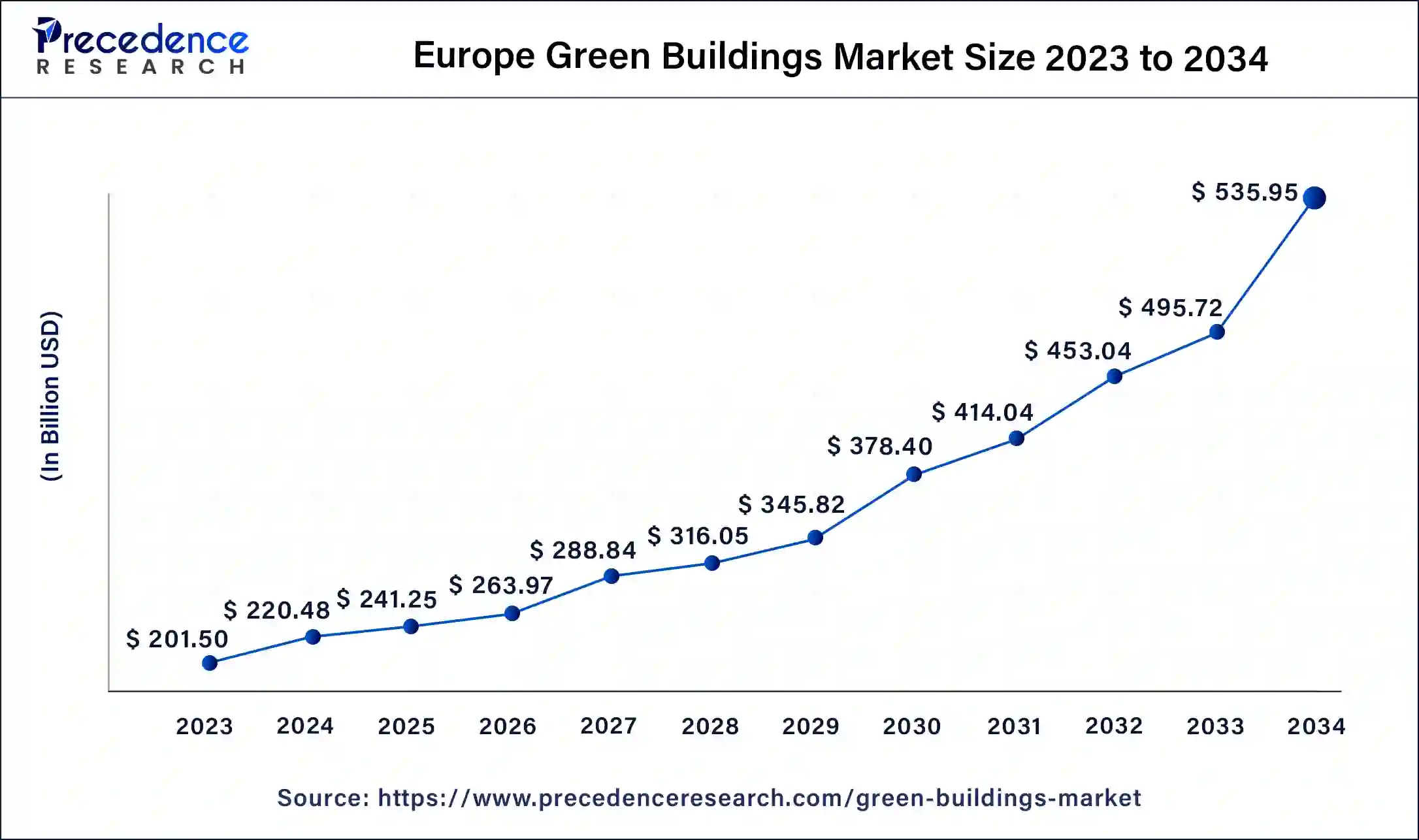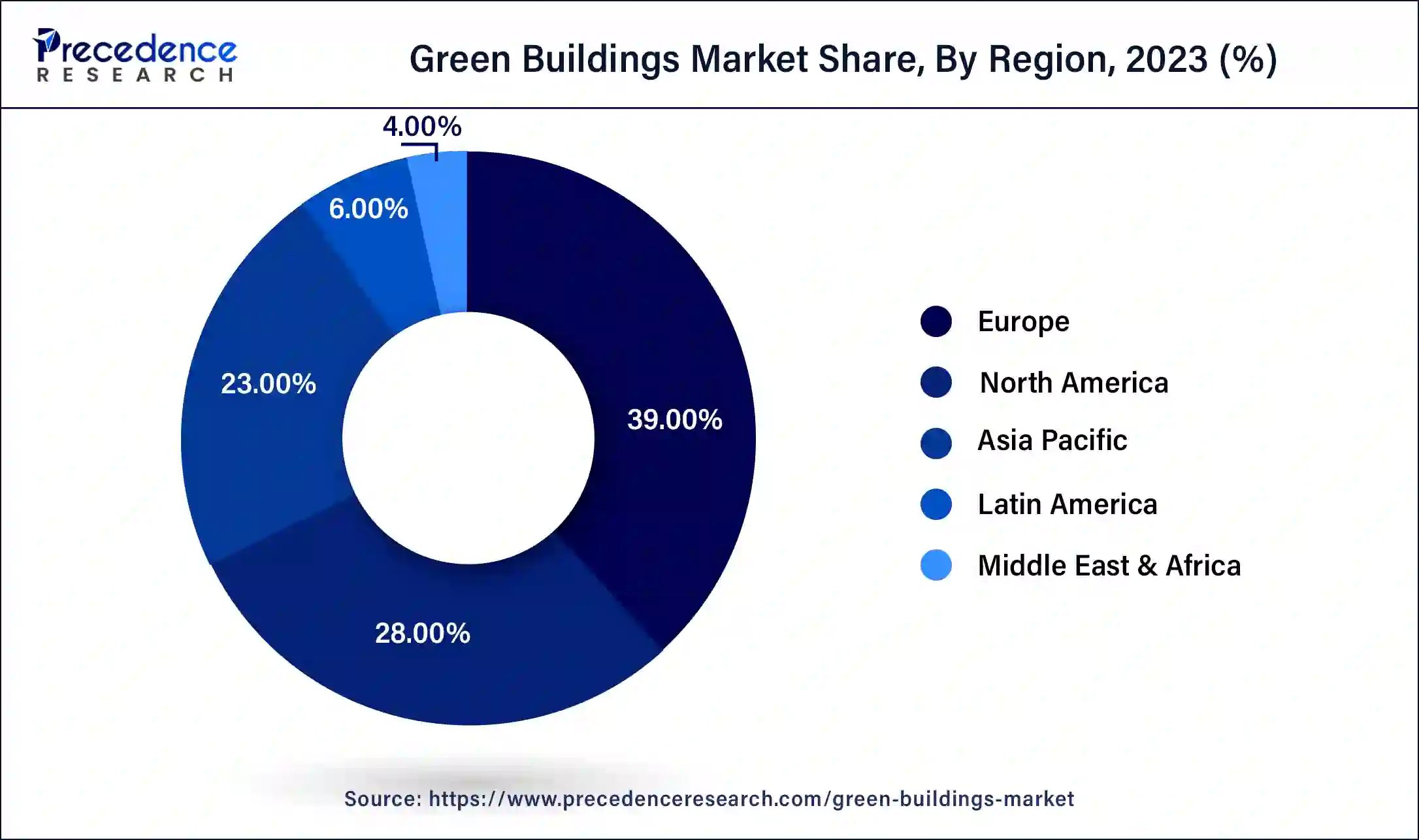March 2025
The global green buildings Market size was USD 516.66 billion in 2023, estimated at USD 565.33 billion in 2024 and is anticipated to reach around USD 1374.23 billion by 2034, expanding at a CAGR of 9.3% from 2024 to 2034.
The global green buildings market size accounted for USD 565.33 billion in 2024 and is predicted to reach around USD 1374.2 billion by 2034, growing at a CAGR of 9.42% from 2024 to 2034.

The Europe green buildings market size was valued at USD 201.50 billion in 2023 and is expected to be worth USD 535.95 billion by 2033, growing at a CAGR of 10% from 2024 to 2034.

Europe has held the largest revenue share of 39% in 2023. The European green building market is flourishing as the region places a strong emphasis on sustainability and environmental responsibility. Stringent regulations, such as the EU's commitment to achieving carbon neutrality, are driving the adoption of green building practices. Innovative trends include the integration of smart building technologies, coupled with an increasing use of sustainable materials. The growing focus on green certifications like BREEAM (Building Research Establishment Environmental Assessment Method) further solidifies Europe's commitment to eco-friendly construction.
Asia Pacific is estimated to observe the fastest expansion. In this region, the green building market is witnessing robust growth due to expanding urbanization and a rising awareness of sustainability. Despite the dominant role of coal as an energy source, there is a growing interest in renewable energy integration, especially in countries like China and India. This interest aligns with environmental concerns and energy efficiency. The region is also investing in green certifications and smart building technologies to meet the growing demand for energy-efficient and eco-conscious construction.

The North American green building market is undergoing a significant transformation, with a shift towards cleaner and more sustainable construction practices. The region is embracing eco-conscious building designs and regulations that promote energy efficiency and environmental responsibility. The adoption of renewable energy solutions, such as solar panels and wind turbines, is on the rise, aligning with the continent's commitment to reducing carbon emissions and fostering a greener, more sustainable future.
Green buildings are integral to creating sustainable and efficient building structures, impacting design, construction, maintenance, and renovation. They are known for their high energy efficiency and utilization of renewable waste sources. These materials encompass various options, including mycelium, hempcrete, recycled plastic, straw bales, bamboo, wood, rammed earth, timbercrete, and grasscrete, offering eco-friendly alternatives for construction.
Sustainable building principles encompass a range of strategies throughout the building project's lifecycle. Green building materials, such as wood, straw, hemp concrete, recycled plastic, ferrock, mycelium, straw bales, bamboo, rammed earth, wood concrete, and grass concrete, are vital components in building design. They contribute to constructing energy-efficient structures that harmonize with the environment and promote ecological balance. These materials not only enhance sustainability but also originate from renewable waste sources, making them exceptionally energy efficient. Utilizing environmentally friendly building materials addresses environmental challenges like air pollution, resource depletion, species extinction, and climate change. Given these advantages, green building materials stand as a significant replacement for conventional construction materials.
| Report Coverage | Details |
| Growth Rate from 2024 to 2034 | CAGR of 9.30% |
| Market Size in 2023 | USD 516.66 Billion |
| Market Size in 2023 | USD 565.33 Billion |
| Market Size by 2034 | USD 1374.23 Billion |
| Largest Market | Europe |
| Base Year | 2023 |
| Forecast Period | 2024 to 2034 |
| Segments Covered | Product Type, End User, and Region |
| Regions Covered | North America, Europe, Asia-Pacific, Latin America, and Middle East & Africa |
Energy efficiency and cost savings
Energy efficiency plays a pivotal role in driving market demand. Green buildings prioritize energy efficiency as a central design principle. As energy costs continue to escalate, the appeal of green buildings becomes increasingly clear due to their ability to deliver substantial reductions in operational expenses. This financial advantage is a significant driving force for both businesses and homeowners, compelling them to adopt green building solutions that not only curtail monthly utility bills but also contribute to a reduced environmental footprint.
The higher the energy efficiency of a building, the more enticing it becomes for prospective occupants, resulting in a noticeable surge in market demand. Both businesses and homeowners are drawn to green building solutions due to their potential to lower monthly utility bills while simultaneously reducing the environmental footprint. The greater a building's energy efficiency, the more appealing it becomes to potential occupants, driving a surge in market demand.
Moreover, cost savings are a powerful incentive for the adoption of green building practices. Despite potentially higher initial construction costs attributed to sustainable materials and technologies, green buildings offer compelling long-term savings that far surpass the initial investment. These structures are built with durability in mind, requiring less maintenance over their lifespan.
Additionally, they often incorporate advanced technologies that enhance resource efficiency, from energy-saving lighting systems to water-conserving fixtures. The combination of reduced maintenance expenses and enhanced resource efficiency positions green buildings as cost-effective choices. This financial viability serves as a strong incentive for investors, building owners, and occupants, fostering a growing demand for green building solutions in the market.
Higher initial costs and perceived complexity
The higher initial costs associated with green building projects can be a significant deterrent. While green buildings promise long-term operational savings, the upfront investments in sustainable materials, technologies, and design may be more substantial than conventional construction. This financial barrier can discourage builders, investors, and property developers, especially when focusing on short-term budget considerations rather than the long-term benefits of lower operating costs and environmental impact. The perception that green construction is an expensive endeavor can hinder the market's growth, despite the clear advantages of sustainability and energy efficiency.
Moreover, the perceived complexity of green building projects can deter stakeholders. The implementation of sustainable materials, energy-efficient systems, and adherence to various green building certifications can seem overwhelming. The lack of awareness or understanding of these eco-friendly practices can create a perception of complexity, leading to hesitation and reluctance in adopting green construction. Overcoming this challenge requires improved education and communication to demystify the process and demonstrate that green building practices are feasible and beneficial.
Green building consulting services and renewable energy solutions
Green building consulting services play a pivotal role in surging the market demand for the green building market. They provide valuable expertise in sustainable construction practices, helping clients navigate the complex landscape of green building regulations, certifications, and design considerations. By offering guidance on eco-friendly materials, energy-efficient systems, and environmentally responsible construction methods, these services empower builders and developers to make informed decisions that align with sustainability objectives. This not only ensures compliance with green building standards but also enhances a project's marketability. As a result, more construction projects seek the expertise of green building consultants to capitalize on the environmental and economic benefits of sustainable building practices.
Renewable energy solutions are a potent driver in boosting the demand for green buildings. These solutions encompass the integration of solar panels, wind turbines, and other renewable energy sources directly into building designs. This on-site energy generation substantially lessens the dependency on traditional energy sources, resulting in reduced operational costs. This heightened energy efficiency not only appeals to environmentally conscious consumers and investors but also aligns with the global imperative to combat climate change and curtail greenhouse gas emissions. The growing accessibility and affordability of renewable energy solutions provide a compelling incentive for the widespread adoption of green building practices, thus amplifying the market's growth.
The exterior products segment has held a 47% revenue share in 2023. Exterior products in the green building market encompass a wide range of elements designed to enhance a building's sustainability and energy efficiency. These include energy-efficient windows, insulated siding, cool roofs, and sustainable landscaping. Trends in exterior products focus on improving insulation and weatherproofing, enhancing natural lighting, and employing eco-friendly materials.
Cool roofs, for instance, are gaining popularity due to their reflective surfaces, which reduce heat absorption, leading to lower cooling costs. Sustainable landscaping with native plants not only enhances aesthetics but also conserves water and promotes biodiversity, aligning with the broader trend of ecological responsibility in green construction.
The solar products segment is anticipated to expand at a significant CAGR of 8.2% during the projected period. Solar products, such as photovoltaic panels and solar water heaters, are integral components of the green building market. Photovoltaic technology is a dominant trend, with an increasing emphasis on incorporating solar panels into building designs. Solar windows and building-integrated photovoltaics (BIPV) are emerging trends, allowing solar energy generation while optimizing space utilization. Solar products contribute to energy self-sufficiency, lower operating costs, and reduced carbon emissions, making them an essential aspect of sustainable building practices in the green construction sector.
In 2023, the residential segment had the highest market share of 43% based on the end user. In the green building market, residential end users refer to individuals and families who occupy eco-friendly and energy-efficient homes. The trend in residential green building revolves around the integration of sustainable materials, energy-efficient appliances, and eco-conscious design. This includes features such as solar panels, energy-efficient lighting, improved insulation, and indoor air quality systems. Homeowners are increasingly drawn to green buildings to reduce their environmental footprint, lower utility bills, and enjoy healthier living spaces.
The commercial segment is anticipated to expand fastest over the projected period. Commercial end users in the green building market pertain to businesses and organizations occupying environmentally responsible office spaces, retail outlets, and industrial facilities. The trend in commercial green buildings emphasizes energy-efficient lighting, HVAC systems, green roofs, and sustainable construction materials. Commercial entities opt for green buildings to reduce operational costs, enhance corporate social responsibility, and meet sustainability goals. Additionally, such structures often feature open, flexible layouts that cater to modern work environments and promote employee well-being.
Segments Covered in the Report
By Product Type
By End User
By Geography
For inquiries regarding discounts, bulk purchases, or customization requests, please contact us at sales@precedenceresearch.com
No cookie-cutter, only authentic analysis – take the 1st step to become a Precedence Research client
March 2025
August 2023
February 2024